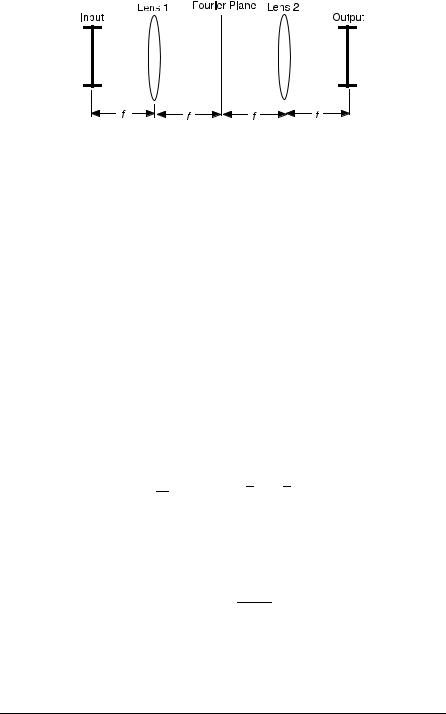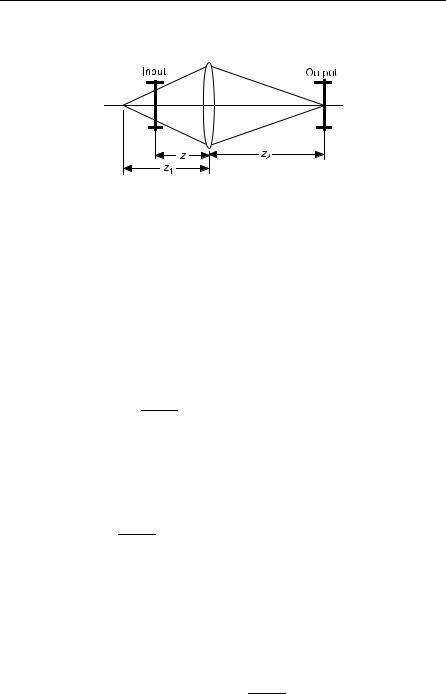
Ersoy O.K. Diffraction, Fourier optics, and imaging (Wiley, 2006)(ISBN 0471238163)(427s) PEo
.pdf148 FOURIER TRANSFORMS AND IMAGING WITH COHERENT OPTICAL SYSTEMS
of U1ðxÞ by the operator O(u) characterized by a variable u. Below the most important operators are described.
1. Fourier transform
|
|
|
|
|
1 |
|
|
|
|
|
|
U2ðvÞ ¼ FðvÞ½U1ðxÞ& ¼ |
ð |
U1ðxÞe j2pvxdx |
ð9:7-1Þ |
||||
|
|
|
|
|
1 |
|
|
|
|
where n denotes frequency. |
|
|
|
|
|
|
|||
2. Free-space propagation |
|
|
|
|
|
|
|
||
|
|
|
|
1 |
|
|
|
|
|
|
|
|
1 |
ð |
|
|
k |
2 |
|
U2 |
ðx2 |
Þ ¼ PðzÞ½U1ðx1 |
Þ& ¼ pjlz |
U1 |
ðx1Þe j |
2z |
ðx2 x1Þ dx1 |
ð9:7-2Þ |
|
|
|
|
|
1 |
|
|
|
|
|
where k ¼ 2p=l, l is the wavelength, and z is the distance of propagation.
For a distance of propagation closer than the Fresnel region, the angular spectrum method can be used instead of Fresnel diffraction.
3. |
Scaling by a constant |
|
ðxÞ& ¼ pj j |
|
|
|
|
|
|
|
|
|
2ð |
x |
Þ ¼ SðaÞ½U1 |
U |
1ð |
ax |
Þ |
ð : |
7-3 |
Þ |
|
|
U |
|
a |
|
|
9 |
|
||||
|
where a is a scaling constant. |
|
|
|
|
|
|
|
|
||
4. |
Multiplication by a quadratic phase factor |
|
|
|
|
|
|
|
|||
|
U2ðxÞ ¼ QðbÞ½U1ðxÞ& ¼ e j 2k bx2 U1ðxÞ |
ð9:7-4Þ |
|||||||||
|
where b is the parameter controlling the quadratic phase factor. |
|
|
|
|||||||
Each of these operators has an inverse. They are shown in Table 9.1.
In order to use the operator algebra effectively, it is necessary to show how two successive operations are related. These relationships are summarized in Table 9.2.
In this table, each element, say, E equals the successive operations with the row operator R(v1) followed by the column operator C(v2):
|
E ¼ Cðv2ÞRðv1Þ |
|
|
|
ð9:7-5Þ |
||
Table 9.1. Inverse operators. |
|
|
|
|
|
|
|
|
|
|
|
|
|
|
|
|
FðnÞ |
PðzÞ |
SðaÞ |
QðbÞ |
|||
|
|
|
1 |
|
|
|
|
Inverse Operator |
Fð nÞ |
Pð zÞ |
S |
|
|
Qð bÞ |
|
a |
|||||||


150 FOURIER TRANSFORMS AND IMAGING WITH COHERENT OPTICAL SYSTEMS
Figure 9.10. Final optical system for Example 9.2.
(c) Let us follow up each operator as an integral equation:
|
|
|
1 |
|
|
|
|
|
|
|
U2ðn1Þ ¼ Fðn1Þ½U1ðxÞ& ¼ |
ð |
U1ðxÞe j2pn1xdx |
||||||||
1 |
|
|
|
|
|
|
||||
U3ðn1Þ ¼ S |
|
½U2ðn1Þ& ¼ p1lf |
1 |
|
|
|
|
|||
1 |
ð U1ðxÞe j2p |
n1 |
xdx |
|||||||
lf |
||||||||||
lf |
||||||||||
|
|
|
1 |
|
1 |
|
|
|
|
|
U4ðn2Þ ¼ Fðn2Þ½U3ðn1Þ& ¼ |
ð |
U3ðn1Þe j2pn2n1 dr1 |
||||||||
|
|
|
1 |
|
|
|
|
|
||
U5ðn2Þ ¼ S l1f ½U4ðn2Þ& ¼ p1lf |
1 |
|
|
|
|
|||||
ð U3ðr1Þe j2pnl2f n1 dn1 |
||||||||||
|
|
|
|
|
1 |
|
|
|
|
|
Using the integral equation for U3ðn1Þ, the last equation is written as
ð1ð
U5ðn2Þ ¼ 1 U1ðxÞe j2pnl1f xe j2pnl2f r1 dxdv1
lf
|
|
1 |
|
|
|
|
|
|
1 |
1 |
|
|
1 |
|
xþv2 |
|
|
|
|
|
|
|
|
|||
|
|
1 |
|
4 1 |
|
|
5 |
|
¼ |
lf |
ð |
U1ðxÞdx2 ð e j2pð |
lf Þv1 dv13 |
||||
|
|
1 |
|
|
x þ v2 |
|
|
|
|
1 |
ð |
U |
x |
dx |
|
||
¼ lf |
lf |
|
||||||
1 |
ð Þd |
|
|
|
||||
|
|
1 |
|
|
|
|
|
|
1ð
¼U1ðxÞdðx þ n2Þdx
1
¼ U1ð n2Þ


152 FOURIER TRANSFORMS AND IMAGING WITH COHERENT OPTICAL SYSTEMS
This yields |
|
|
|
|
|
|
|
|
|
|
|
|
|
|
|
|
|
|
|
|
|
|
|
|
|
|
|
|
|
|
|
|
O |
¼ |
Q |
|
z1 þ z2 |
Q |
|
|
z1 þ z2 |
|
S |
|
|
z1 |
|
S |
|
|
|
1 |
|
|
|
F r |
|||||||||
|
|
|
|
|
|
|
|
|
|
|
|
|
|
|
|
|
|
|
|
|||||||||||||
|
|
z22 |
|
|
|
z12 |
|
z2 lðz z2Þ |
ð Þ |
|||||||||||||||||||||||
Combining successive Q as well as S operations results in |
|
|
|
|||||||||||||||||||||||||||||
|
|
O |
¼ |
Q |
ðz1 þ z2Þz z1z2 |
|
S |
|
|
z1 |
|
|
|
|
F r |
Þ |
|
|||||||||||||||
|
|
|
|
|
|
z1 |
|
|
z |
|
|
|||||||||||||||||||||
|
|
|
|
|
z22 |
ð |
z |
|
z1 |
Þ |
|
|
lz2 |
ð |
|
ð |
|
|||||||||||||||
|
|
|
|
|
|
|
|
|
|
|
|
|
|
|
|
|
|
|
|
Þ |
|
|
|
|
||||||||
As an integral equation, O corresponds to |
|
|
|
|
|
|
|
|
|
|
|
|
|
|
|
|
|
|||||||||||||||
|
|
|
|
|
|
|
jkðz1þz2Þz z1z2x2 |
1 |
|
|
|
|
|
|
|
2pz1x0 |
|
|
|
|||||||||||||
|
|
U2ðx2Þ ¼ e 2 |
|
z2ðz1 zÞ |
|
0 |
ð |
U1ðxÞe j |
|
xdx |
|
|||||||||||||||||||||
|
|
|
|
lz2ðz1 zÞ |
|
|||||||||||||||||||||||||||
|
|
|
|
|
|
|
|
|
|
|
2 |
|
|
|
|
1 |
|
|
|
|
|
|
|
|
|
|
|
|
|
|
||
|
|
|
|
|
|
|
|
|
|
|
|
|
|
|
|
|
|
|
|
|
|
|
|
|
|
|
|
|
|
|||
By varying z, the spatial frequency |
|
z1x0 |
|
can be adjusted. |
|
|
|
|||||||||||||||||||||||||
z2 |
ðz1 zÞ |
|
|
|
||||||||||||||||||||||||||||
|
|
|
|
|
|
|
|
|
|
|
|
|
|
|
|
|
|
|
|
|
|
|
|
|
|
|
|
|
||||




156 IMAGING WITH QUASI-MONOCHROMATIC WAVES
Solution: Using Parseval’s theorem, we write
1 |
|
|
|
|
1 |
|
|
|
|
|
|
|
|
ð |
uðtÞvðtÞdt ¼ |
ð |
Uð f ÞV ð f Þdf |
|
|
||||||||
1 |
|
|
|
|
1 |
|
|
|
|
|
|
||
|
|
|
|
|
1 |
|
|
|
|
0 |
|
||
|
|
|
|
¼ j ð jUð f Þj2df j |
ð |
jUð f Þj2df ¼ 0 |
|||||||
|
|
|
|
|
0 |
|
|
|
|
|
1 |
ð10:2-11Þ |
|
|
Uðf Þ ¼ U1ð f Þ jU0ð f Þ |
|
|||||||||||
|
u1 |
ð |
t |
Þ ¼ |
1 |
|
ð |
Þ þ |
u |
ð |
Þ |
|
|
|
1 |
|
|
||||||||||
|
|
|
2 |
|
u t |
|
t |
|
|
|
|||
|
x y 0ðzÞ ¼ |
2 uðtÞ uð tÞ |
|
|
|||||||||
|
u |
|
t |
|
|
|
|
|
|
|
|
|
|
|
ð 0; 0; |
|
Þ |
|
|
|
|
|
|
|
|
|
|
t2 t1
because Uð f Þ ¼ U ð f Þ.
EXAMPLE 10.3 The FT of uðtÞ can be written as
Uð f Þ ¼ U1ðf Þ jU0ð f Þ
where U1ð f Þ and U0ð f Þ are the cosine and sine parts of the FT of uðtÞ.
Show that U1ð f Þ and U0ð f Þ are a Hilbert transform pair when uðtÞ is a causal signal (uðtÞ equals zero for negative t).
Solution: The even and odd parts of uðtÞ can be written as
1
u1ðtÞ ¼ 2 ½uðtÞ þ uð tÞ&
1
u0ðtÞ ¼ 2 ½uðtÞ uð tÞ&
When uðtÞ is causal, it is straightforward to show that
u1ðtÞ ¼ u0ðtÞsgnðtÞ |
||
|
|
ð10:2-14Þ |
u0ðtÞ ¼ u1ðtÞsgnðtÞ |
||
Then, |
|
|
|
1 |
|
U1ð f Þ ¼ |
ð |
u1ðtÞe j2pftdt |
|
1 |
ð10:2-15Þ |
|
1 |
|
¼ |
ð |
u0ðtÞsgnðtÞe j2pftdt |
|
1 |
|

